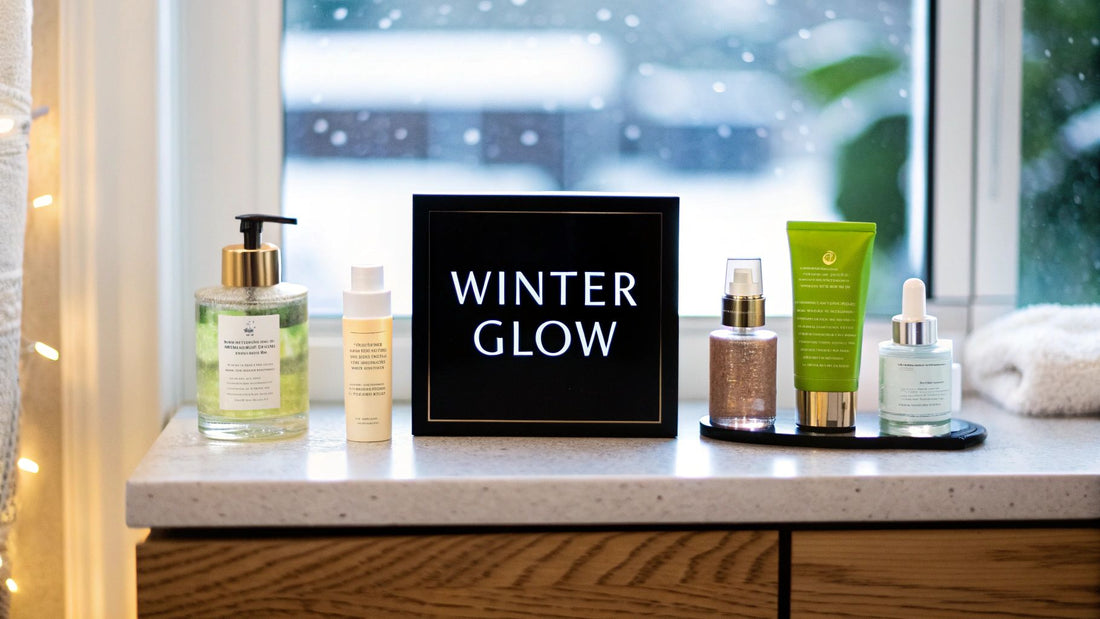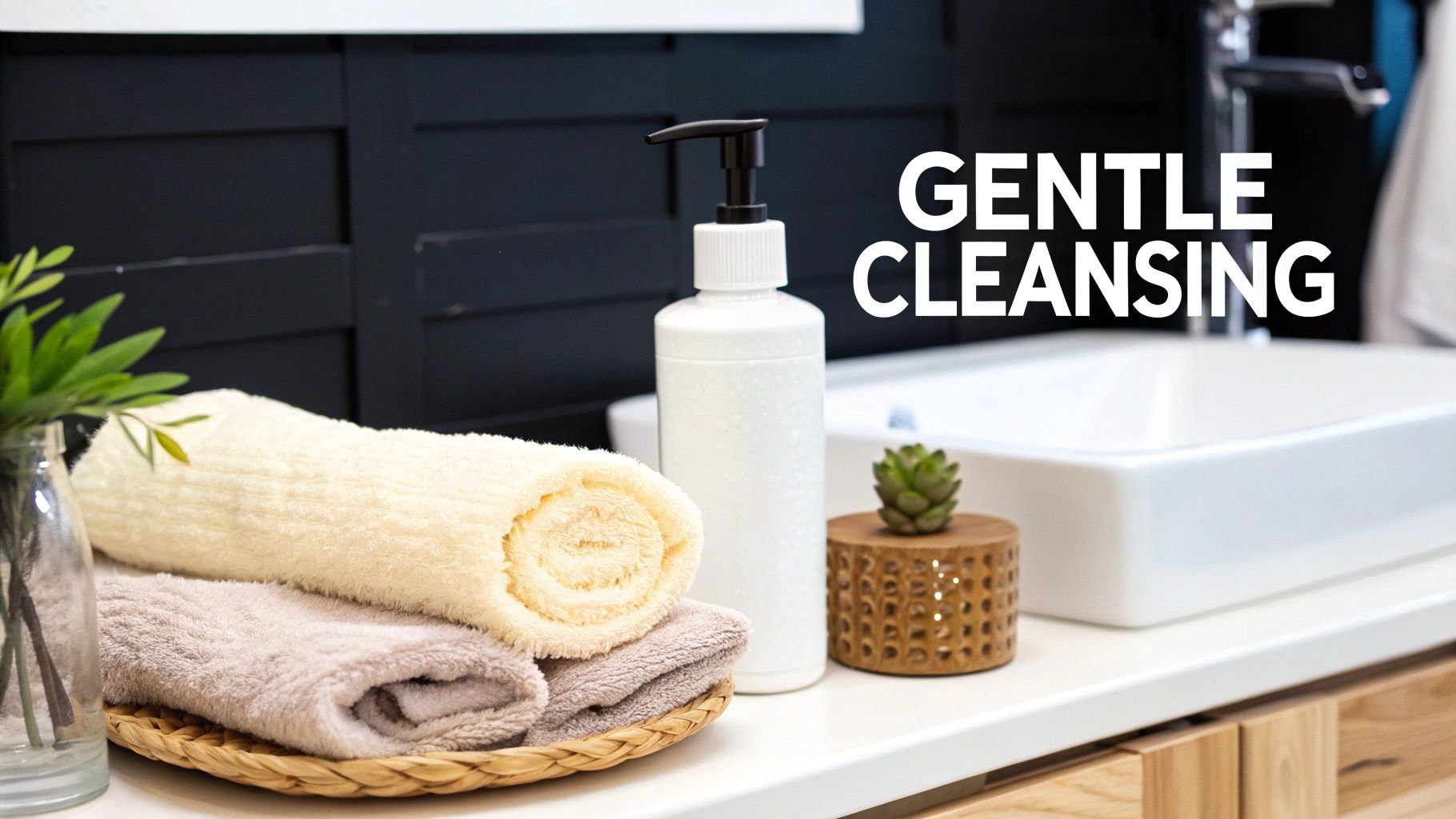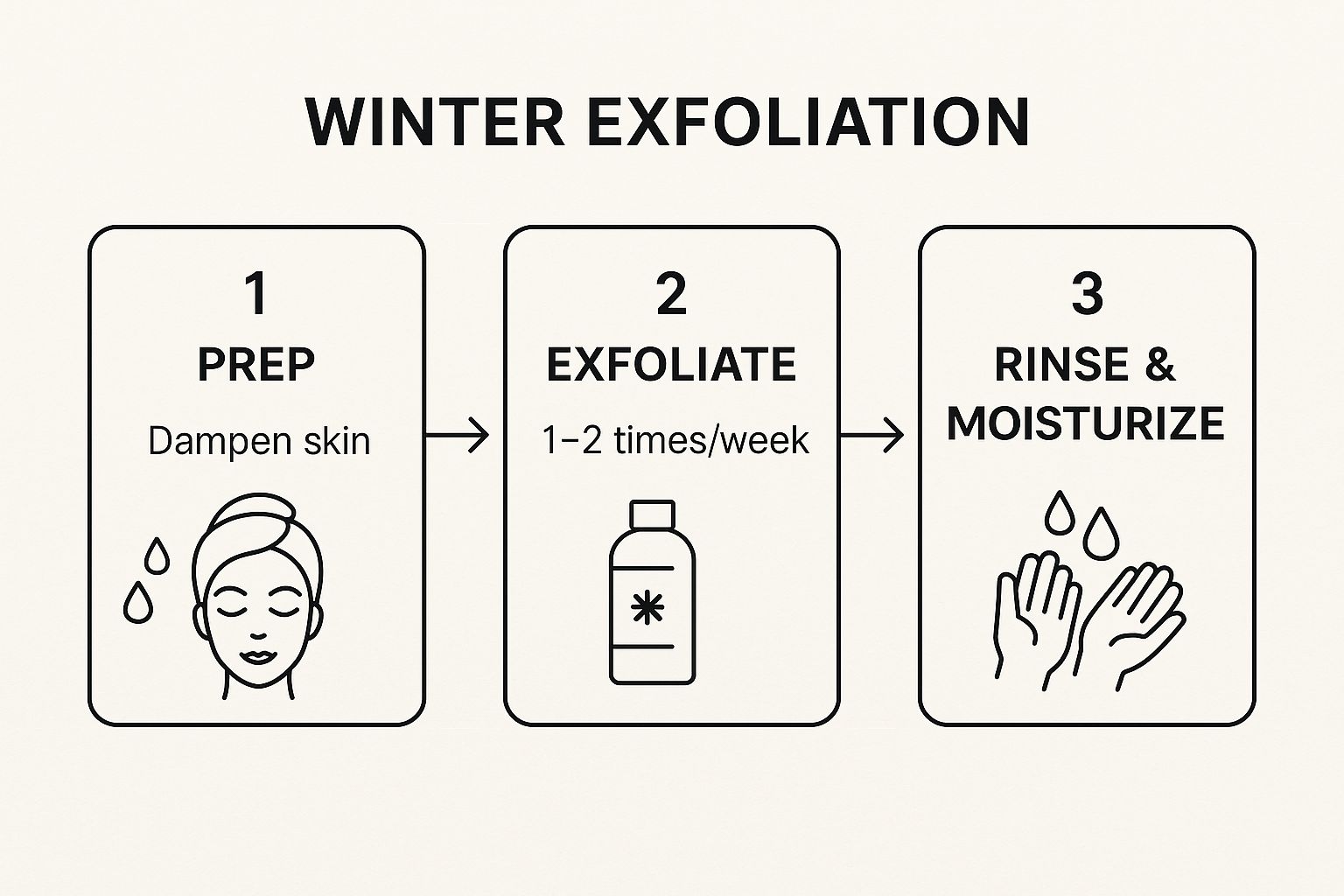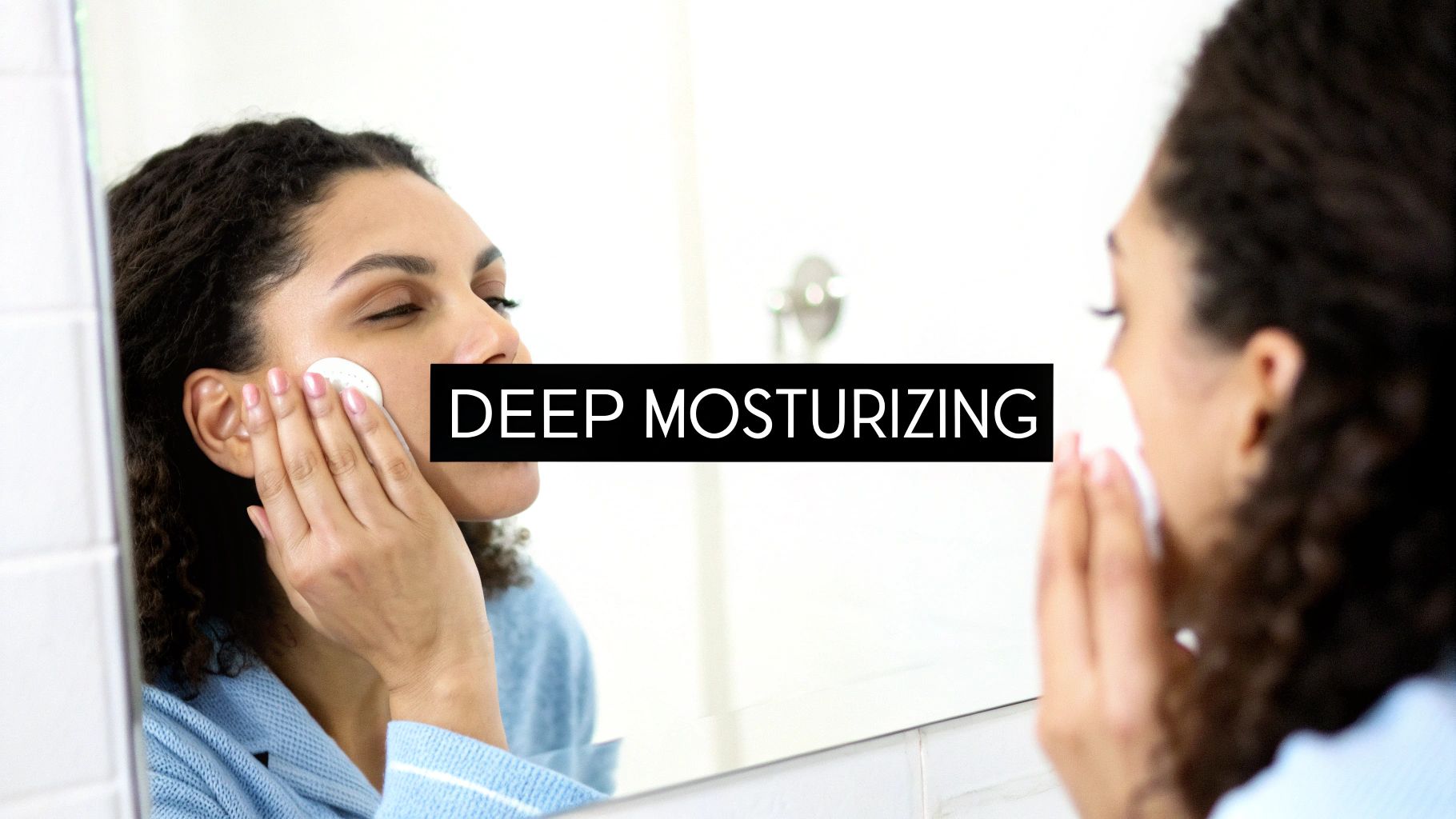
Create the Perfect Skincare Routine for Winter | Expert Tips
Share
A dedicated skincare routine for winter is your best line of defence when the seasons turn. That seasonal shift can leave your skin feeling uncomfortably tight, dry, and generally unhappy. It’s all about swapping out those lighter summer products for richer, more nourishing formulas designed to shield your skin’s natural barrier from the cold, dry air.
Why Your Skin Hates Winter
Ever notice how your skin goes from perfectly happy one day to stressed and sensitive the next, seemingly the moment the temperature plummets? It’s not just in your head. The brutal combination of cold outdoor air, low humidity, and the dry blast of indoor heating creates the perfect storm, conspiring to rob your skin of its precious moisture.
This environmental assault goes straight for your skin's protective barrier—that vital layer of lipids responsible for locking moisture in and keeping irritants out. In winter, this barrier takes a real beating and weakens, making it much easier for water to evaporate from the skin. This process, known as transepidermal water loss (TEWL), is the main culprit behind that tight, flaky, and sometimes red look we associate with "winter skin." It's more than a minor annoyance; a compromised barrier can lead to heightened sensitivity, irritation, and inflammation.
The Science Behind Seasonal Skin Distress
Think of your skin's outermost layer, the stratum corneum, as a well-built brick wall. Your skin cells are the bricks, and the natural lipids, like ceramides and fatty acids, are the mortar holding it all together. Winter attacks this structure from two main angles:
- Low Humidity: It’s a simple fact of physics: cold air holds far less moisture than warm air. When the air around you is dry, it essentially tries to rebalance itself by pulling moisture from wherever it can—including your skin.
- Indoor Heating: Just when you think you’ve escaped the cold, you walk into a centrally heated home or office. That warm, dry air might feel cosy, but it only accelerates the moisture loss from your skin's surface.
This constant tug-of-war leaves your skin dehydrated and vulnerable. It’s exactly why the moisturiser that felt perfect in July suddenly seems to do nothing by November. Your skin isn’t just thirstier; its fundamental defences are being challenged every single day.
Shifting Skincare Priorities in the UK
This all-too-common skin struggle has led to a real shift in how we approach skincare here in the UK. Building a specific winter routine is no longer a niche concern; it's become a major focus for many. This trend is part of a wider market boom that saw skincare value sales climb by an impressive 7.9% in 2024, even while other retail sectors slowed down.
This growth points to a greater collective understanding of our skin's seasonal needs, particularly during our often harsh winter months. A typical UK winter routine now rightly prioritises heavier moisturisers and barrier-repairing skincare products to counteract the drying effects of the cold. If you're interested in the data, you can find more on these market trends and consumer insights on Mintel.
The takeaway is simple: moving to more supportive skincare products isn't just a passing trend. It's a necessary strategy to keep your skin feeling comfortable, looking healthy, and staying resilient all winter long. Understanding this is the first step toward building an effective skincare routine for winter.
Building Your Morning Protection Ritual

Your morning skincare routine is your first line of defence against the harsh realities of winter. Think of it as building a protective shield that hydrates and fortifies your skin, preparing it for everything from biting winds to the dry, stuffy air of central heating.
Start with a Gentle Cleanser
The golden rule for a winter morning cleanse? Be gentle. Your goal is simply to freshen up and remove any residue from the night, not to strip away the precious natural oils that keep your skin protected. Those foaming and gel cleansers you loved in summer can often be too aggressive when your skin is already feeling vulnerable.
Instead, I always recommend switching to a cream, milky, or oil-based cleanser. These skincare products do a beautiful job of cleaning the skin while also depositing nourishing ingredients. Your face should feel soft and comfortable afterwards, never tight or squeaky. This one change is a cornerstone of an effective skincare routine for winter.
Layer on Hydration and Antioxidants
With your skin clean and prepped, it's time to layer in the good stuff. This step is like giving your skin a huge drink of water before it faces the dehydrating conditions of a winter's day. A hydrating serum is absolutely non-negotiable in the colder months.
I tell my clients to look for serums packed with powerhouse ingredients like these:
- Hyaluronic Acid: A true hydration hero. This humectant can hold up to 1,000 times its weight in water, pulling moisture deep into the skin for that plump, dewy feel.
- Glycerin: Another brilliant humectant that helps your skin hang onto moisture for longer.
- Vitamin C: This isn't just for brightening! As an antioxidant, it provides vital protection against environmental damage from things like pollution and UV rays.
Here’s a pro tip: apply your serum to slightly damp skin. This helps boost absorption, making it work even harder for you. Understanding how to layer skincare products is fundamental, and you can dive deeper into this in our guide on the ultimate skincare routine for radiant, healthy skin.
Seal It All In with the Right Moisturiser
Now for the hero of your morning ritual: the moisturiser. Its job is to lock in all that lovely hydration from your serum and create a solid barrier between your skin and the cold, dry air. That lightweight lotion that felt perfect in July just isn't going to cut it now.
In winter, your moisturiser needs to do more than just hydrate; it must protect. Look for richer creams containing both emollient and occlusive ingredients to create a comprehensive shield.
The best winter moisturisers contain a blend of ingredients that work together to support your skin's health.
Key Moisturiser Ingredients for Winter
| Ingredient Type | What It Does | Examples |
|---|---|---|
| Emollients | Soften and smooth the skin's surface by filling in tiny gaps between cells. | Shea Butter, Squalane, Fatty Acids |
| Occlusives | Form a physical barrier on top of the skin to prevent moisture from escaping. | Petrolatum, Lanolin, Dimethicone |
| Humectants | Act like magnets, attracting water to the skin for deep hydration. | Hyaluronic Acid, Glycerin, Honey |
Even if your skin is oily or prone to breakouts, please don't skip this step. Just look for a non-comedogenic cream that provides that essential barrier support without clogging your pores. The right moisturising skincare product will leave your skin feeling resilient and ready for whatever the day throws at it.
Your Nighttime Repair and Recovery Plan
While your morning routine is all about protecting your skin from the elements, your nighttime ritual is where the real magic happens. Think of it as a dedicated repair shift. As you sleep, your skin gets to work regenerating, and the right skincare products can give it a powerful boost to undo the day's damage and prep for whatever tomorrow throws at it.
The Power of the Double Cleanse
First things first: you need a completely clean slate. In winter, this means getting rid of makeup, daily grime, and that layer of SPF you so diligently applied. The best way I’ve found to do this without leaving my skin feeling tight and stripped is double-cleansing. It’s a non-negotiable step if you wear long-lasting makeup or mineral-based sunscreens.
Start with an oil or balm cleanser on dry skin. Really take a moment to massage it in; you'll feel it melting away everything from stubborn mascara to pollutants. Then, rinse and follow up with a gentle, milky, or cream-based cleanser. This second step ensures your skin is impeccably clean but still feels soft and comfortable. No squeakiness allowed.
Introduce Targeted Treatments Wisely
With your skin perfectly prepped, it's time for targeted treatments. This is your chance to tackle specific concerns, whether it's fine lines, dullness, or that persistent feeling of dehydration. But a word of caution: winter skin is more fragile, so you need to be smart about using potent active ingredients.
- Retinoids: If a retinoid is part of your routine, you don't have to stop using it. Instead, try dialing back the frequency to every other night. Another great trick is "buffering"—applying a thin layer of a simple, no-frills moisturiser before your retinoid. It creates a gentle buffer that minimises irritation without blocking the benefits.
- Exfoliating Acids: Ditch the harsh, gritty physical scrubs. In winter, they can do more harm than good. A much better option is a gentle chemical exfoliant, like lactic acid (great for hydration) or mandelic acid (perfect for sensitive skin). Use it just once or twice a week to slough off dead cells without compromising your skin's protective barrier.
This visual guide breaks down a smart and gentle approach to winter exfoliation.

The key takeaway? Gentle does it. Prepping your skin before and caring for it after are just as important as the exfoliation itself.
Before we dive into the final moisturising steps, let's talk about making smart swaps for the season. Upgrading your routine doesn't mean buying all new skincare products; sometimes, it's just about a few key changes.
Smart Winter Skincare Swaps
Upgrade your routine for cold weather by swapping out summer staples for these nourishing, winter-ready alternatives.
| Skincare Step | Your Summer Go-To | Your Winter Upgrade | Why It Works Better |
|---|---|---|---|
| Cleanser | Foaming Gel Cleanser | Cream, Milk, or Balm Cleanser | Cleans effectively without stripping away essential natural oils your skin needs in the cold. |
| Toner | Astringent or Alcohol-Based | Hydrating Essence or Toner | Adds an extra layer of moisture with ingredients like hyaluronic acid or glycerine, rather than drying skin out. |
| Moisturiser | Lightweight Gel-Cream | Rich Cream with Ceramides | Provides a more robust barrier to lock in hydration and protect against harsh winds and dry indoor heat. |
| Exfoliant | Physical Scrub or Glycolic Acid | Lactic Acid or PHA Toner | Gentler alpha-hydroxy acids (AHAs) and polyhydroxy acids (PHAs) exfoliate without causing irritation or sensitivity. |
| Night Treatment | Light Serum | Facial Oil or Sleeping Mask | Creates an occlusive seal to prevent moisture loss overnight, allowing you to wake up with plump, hydrated skin. |
These simple trades can make a world of difference in keeping your skin happy and healthy through the colder months.
Focus on Barrier Repair and Deep Moisturization
The final, and arguably most important, step in your nighttime routine is to lock everything in, rebuild your skin's barrier, and deeply moisturise. This has become a massive focus for skincare lovers recently, especially during winter. In fact, the UK beauty industry saw an 11% growth in 2023, reaching a value of £27.2 billion, with a significant portion driven by seasonal skincare products targeting barrier repair. This trend shows a real demand for formulas packed with ingredients like oat extract and biomimetic peptides. If you're interested in the data behind these trends, you can find great insights over at Beauty Independent.
Your goal at night is to create a nourishing cocoon for your skin. This involves layering skincare products rich in ceramides, peptides, and fatty acids—the very building blocks of a healthy skin barrier.
Wrap up your routine with a rich, comforting night cream. If your skin is feeling particularly parched, don't be afraid to go one step further. Add a few drops of a nourishing facial oil into your moisturiser or apply a sleeping mask as the very last step. These skincare products act like a protective blanket, preventing water from escaping overnight. The result? You’ll wake up to skin that feels soft, resilient, and looks visibly healthier.
The Best Ingredients for Winter Skin

Feeling a bit overwhelmed by those long, complicated ingredient lists? You're not alone. Let's cut through the noise. Building a solid skincare routine for winter really boils down to choosing skincare products packed with the right stuff to hydrate, soothe, and protect your skin.
I find it helpful to think about a winter skincare strategy in three core categories: humectants, emollients, and occlusives. Each one has a specific job, but they all work together beautifully to keep your skin healthy and glowing, even when the weather is doing its worst. Once you get your head around these, you’ll feel much more confident scanning product labels.
The Moisture Magnets: Humectants
First on our list are humectants. Think of these as tiny sponges for your skin. They have an amazing ability to pull moisture from the deeper layers of your skin and even from the air around you, drawing it right to the surface for an instant hit of hydration.
This makes them absolutely essential for fighting the drying effects of that biting cold air and constant central heating. Some of the most effective humectants to look out for in your skincare products are:
- Hyaluronic Acid: Famous for its capacity to hold up to 1,000 times its weight in water, it provides intense, plumping hydration.
- Glycerin: A classic, dependable humectant that helps your skin hold onto moisture for much longer.
- Honey: A wonderful natural option that not only hydrates but also has handy antibacterial properties.
By pulling water into the skin's surface, humectants lay the foundation for hydration and stop that tight, uncomfortable feeling in its tracks. They are the first and most critical step towards a deeply moisturised complexion.
The Barrier Builders: Emollients and Occlusives
Next up, we have emollients. These are the ingredients that give moisturisers that lovely smooth, silky texture. They work by filling in the tiny gaps between your skin cells, which is brilliant for softening rough patches and helping to repair your skin's natural barrier. Common examples you’ll see are shea butter, squalane, and various fatty acids.
Finally, there are the occlusives. These create a protective seal over your skin's surface. This physical barrier is a game-changer in winter because it locks in all that lovely moisture from your humectants and emollients, preventing what we call transepidermal water loss. Skincare products with ingredients like petrolatum, lanolin, and dimethicone are fantastic occlusives.
The Soothing Saviours
Winter skin doesn't just need hydration; it often needs a bit of TLC to calm it down and help it repair. This is where soothing agents come in. Recent market analysis in the UK highlights a growing desire for skincare products with multi-tasking ingredients that hydrate, soothe, and tackle inflammation all in one go.
Because of this, ingredients like niacinamide and centella asiatica are becoming staples as people look for more specific advice to deal with environmental skin stress. This trend is supported by reports showing a 10% workforce growth in the British beauty sector in 2023, all driven by this demand. You can read more about how consumers are navigating the UK skincare market on Revieve.com.
Here are a few key repairing ingredients to add to your winter arsenal:
- Ceramides: These are lipids that are already a natural part of your skin barrier. Topping them up helps to rebuild and strengthen it from the inside out.
- Niacinamide: A true workhorse ingredient, it calms redness, boosts barrier function, and can even help to regulate oil production.
- Centella Asiatica (Cica): Well-known for its incredible healing and anti-inflammatory properties, it’s perfect for calming down irritated, sensitised skin.
The real secret to a successful winter regimen is combining these different types of ingredients in your skincare products. For a deeper dive, check out our guide on how hydration is the secret to youthful skin and how to achieve it.
Don't Forget Your Lips and Body

It’s easy to focus so much on your face that you forget your skincare routine should extend well below your jawline. The very same things that wreak havoc on your face—that biting cold air outside and the dry central heating inside—are just as punishing for your lips and body. Often, we don't notice until things get flaky, chapped, and uncomfortable.
Let's talk about lips. The skin here is incredibly thin and has hardly any oil glands, which is why it becomes chapped and flaky so easily. That light, summery gloss just won't cut it. Your new best friend should be a thick, occlusive lip balm that you keep with you at all times. I always look for formulas with ingredients like petrolatum, shea butter, or lanolin to create a proper shield that locks in moisture and keeps the wind out.
And your hands! They’re constantly exposed to the cold, not to mention frequent washing, which strips away their natural oils. The result? Painful cracks and rough, angry skin. An incredibly simple but effective trick is to wear gloves every time you go outside. Think of them as a winter coat, but for your hands.
Nurturing Your Skin From Head To Toe
Caring for the skin on your body during winter means rethinking both your skincare products and your habits. The lightweight lotion you loved in July simply doesn't have the staying power to fight off winter dryness. It’s time to upgrade to something richer and more substantial, like a body butter or a thick, nourishing cream.
The absolute best time to moisturise is right after a shower. Don't rub your skin dry; instead, gently pat it with a towel so it’s still a little damp. Massaging in your body butter at this point helps trap that surface water, locking in an essential layer of hydration that will keep your skin feeling soft all day. If your skin feels desperately thirsty, you might want to dive deeper into our guide on how to treat dehydrated skin for some more intensive solutions.
Create A Skin-Friendly Environment
Beyond what you slather on, a few small changes to your daily life can make a world of difference to how your skin feels this winter.
Your environment plays a huge role in your skin’s condition. Creating a moisture-rich atmosphere indoors can counteract the drying effects of central heating, offering relief for your entire body.
Here are a few easy habits I swear by:
- Take Lukewarm Showers: I know how tempting a scorching hot shower is on a freezing day, but high temperatures strip your skin of its natural protective oils. Turning the heat down just a few notches helps preserve your skin barrier.
- Use a Humidifier: Running a humidifier in your bedroom adds moisture back into the air while you sleep. It’s a game-changer for preventing your skin from drying out overnight.
- Stay Hydrated: You might not feel as thirsty as you do in the summer, but it's just as important to drink plenty of water. It truly helps hydrate your skin from the inside out.
Common Winter Skincare Questions Answered
https://www.youtube.com/embed/006U-_NDZ6Q
Even with the perfect routine mapped out, winter always seems to throw a few curveballs at our skin. Let's dig into some of the most frequent questions I hear, so you can navigate the season with confidence and keep your skin happy.
Do I Really Need SPF in the Winter?
The short answer? Yes, absolutely. This is probably the biggest skincare myth out there—the idea that you can shelve your sunscreen once the clocks go back. While the UVB rays (the ones that cause sunburn) are less intense, the UVA rays are a different story.
UVA rays are the ones responsible for premature ageing, fine lines, and deeper cellular damage, and they are relentlessly present all year round. They slice right through clouds and glass, so you’re getting exposure on grey, drizzly days and even when you’re just sitting near a window working from home. Daily sun protection isn't just a step; it's the foundation of any good skincare routine, no matter the season.
The trick is finding a winter-friendly formula. I always recommend looking for a hydrating SPF, perhaps one with ingredients like hyaluronic acid or glycerin. That way, you’re getting that crucial protection without your skin feeling tight or dry, which some sunscreen skincare products can unfortunately do.
Can I Still Exfoliate My Dry Skin?
Not only can you, but you probably should—just with a much gentler hand. Exfoliation is key in winter for sloughing off that layer of dead, flaky skin. Without it, you get a dull-looking complexion, and all those lovely hydrating serums and creams you're using can't penetrate properly.
But this is definitely the time to step away from harsh physical scrubs. They can cause tiny micro-tears in your skin's barrier, which is already taking a beating from the cold. Instead, it’s a smart move to switch to a gentle chemical exfoliant.
- Lactic Acid: This is a brilliant choice for winter because it does double duty—it exfoliates and has hydrating properties.
- Mandelic Acid: A great one for sensitive types. Its molecules are larger, so it penetrates the skin more slowly, making it incredibly gentle.
The most important part is to scale back how often you do it. If you were exfoliating three times a week in the summer, try cutting back to just once a week. Pay attention to how your skin feels. If you notice any sensitivity, skip it for a few days. The aim here is a gentle refresh, not an aggressive stripping.
My Oily Skin Feels Tight—What Do I Do?
This is such a common complaint, and it highlights a crucial difference: your skin is likely dehydrated, not dry. Oily skin types produce plenty of oil (sebum), but they can still lack water. The combination of cold, windy air outside and dry central heating inside saps moisture from every skin type, including oily ones.
What happens next is a frustrating cycle. When oily skin gets dehydrated, its defence mechanism is often to produce even more oil to compensate. This leads to that awful feeling of being slick on the surface but uncomfortably tight underneath, often with more congestion and breakouts.
The answer isn't to attack the oil with stripping cleansers or harsh toners. You need to focus on putting water back into your skin. Look for lightweight hydrators like gel-cream moisturisers that are loaded with ingredients like hyaluronic acid. These skincare products sink in beautifully, delivering a powerful dose of moisture without feeling heavy, greasy, or clogging your pores. It’s all about rebalancing your skin so it feels comfortable, hydrated, and calm.
At P-Eleven, we believe that the right skincare products can help you navigate any seasonal skin challenge. Explore our curated collections to find the perfect science-backed solutions to keep your skin healthy and glowing all winter long. Discover your ideal routine at p-eleven.com.


